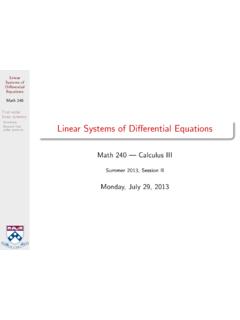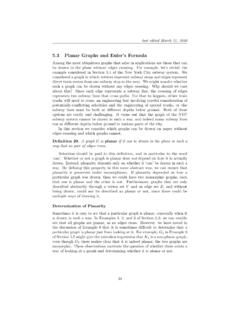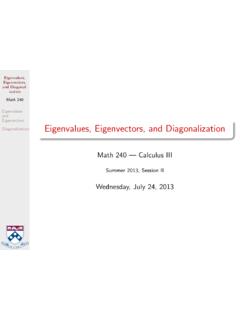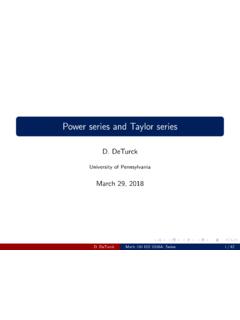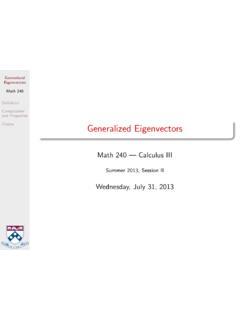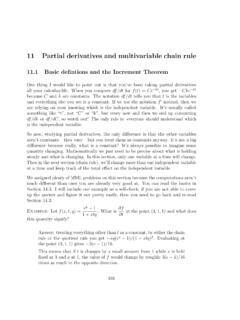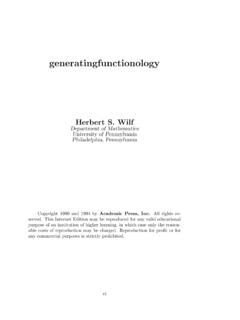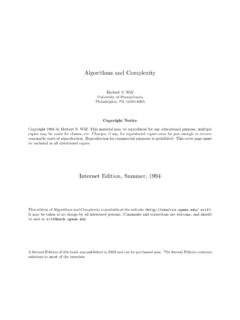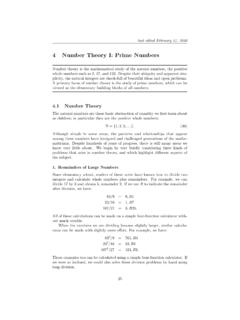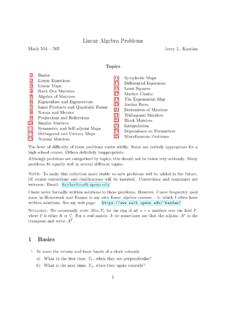Transcription of Properties of Expected values and Variance
1 Properties of Expected values and VarianceChristopher CrokeUniversity of PennsylvaniaMath 115 UPenn, Fall 2011 Christopher CrokeCalculus 115 Expected valueConsider a random variableY=r(X) for some functionr, + 3 so in this caser(x) =x2+ turns out (and wehave already used) thatE(r(X)) = r(x)f(x) is not obvious since by definitionE(r(X)) = xfY(x)dxwherefY(x) is the probability density function ofY=r(X).You get from one integral to the other by careful uses consequence isE(aX+b) = (ax+b)f(x)dx=aE(X) +b.
2 (It is not usually the case thatE(r(X)) =r(E(X)).)Similar facts old for discrete random CrokeCalculus 115 Expected valueConsider a random variableY=r(X) for some functionr, + 3 so in this caser(x) =x2+ turns out (and wehave already used) thatE(r(X)) = r(x)f(x) is not obvious since by definitionE(r(X)) = xfY(x)dxwherefY(x) is the probability density function ofY=r(X).You get from one integral to the other by careful uses consequence isE(aX+b) = (ax+b)f(x)dx=aE(X) +b.(It is not usually the case thatE(r(X)) =r(E(X)).)
3 Similar facts old for discrete random CrokeCalculus 115 Expected valueConsider a random variableY=r(X) for some functionr, + 3 so in this caser(x) =x2+ turns out (and wehave already used) thatE(r(X)) = r(x)f(x) is not obvious since by definitionE(r(X)) = xfY(x)dxwherefY(x) is the probability density function ofY=r(X).You get from one integral to the other by careful uses consequence isE(aX+b) = (ax+b)f(x)dx=aE(X) +b.(It is not usually the case thatE(r(X)) =r(E(X)).)Similar facts old for discrete random CrokeCalculus 115 Expected valueConsider a random variableY=r(X) for some functionr, + 3 so in this caser(x) =x2+ turns out (and wehave already used) thatE(r(X)) = r(x)f(x) is not obvious since by definitionE(r(X)) = xfY(x)dxwherefY(x) is the probability density function ofY=r(X).
4 You get from one integral to the other by careful uses consequence isE(aX+b) = (ax+b)f(x)dx=aE(X) +b.(It is not usually the case thatE(r(X)) =r(E(X)).)Similar facts old for discrete random CrokeCalculus 115 Expected valueConsider a random variableY=r(X) for some functionr, + 3 so in this caser(x) =x2+ turns out (and wehave already used) thatE(r(X)) = r(x)f(x) is not obvious since by definitionE(r(X)) = xfY(x)dxwherefY(x) is the probability density function ofY=r(X).You get from one integral to the other by careful uses consequence isE(aX+b) = (ax+b)f(x)dx=aE(X) +b.
5 (It is not usually the case thatE(r(X)) =r(E(X)).)Similar facts old for discrete random CrokeCalculus 115 Expected valueConsider a random variableY=r(X) for some functionr, + 3 so in this caser(x) =x2+ turns out (and wehave already used) thatE(r(X)) = r(x)f(x) is not obvious since by definitionE(r(X)) = xfY(x)dxwherefY(x) is the probability density function ofY=r(X).You get from one integral to the other by careful uses consequence isE(aX+b) = (ax+b)f(x)dx=aE(X) +b.(It is not usually the case thatE(r(X)) =r(E(X)).)
6 Similar facts old for discrete random CrokeCalculus 115 Expected valueConsider a random variableY=r(X) for some functionr, + 3 so in this caser(x) =x2+ turns out (and wehave already used) thatE(r(X)) = r(x)f(x) is not obvious since by definitionE(r(X)) = xfY(x)dxwherefY(x) is the probability density function ofY=r(X).You get from one integral to the other by careful uses consequence isE(aX+b) = (ax+b)f(x)dx=aE(X) +b.(It is not usually the case thatE(r(X)) =r(E(X)).)Similar facts old for discrete random CrokeCalculus 115 ProblemForXthe uniform distribution on [0,2] what isE(X2)?
7 IfX1,X2,X3,..Xnare random variables andY=r(X1,X2,X3,..Xn) thenE(Y) = .. r(x1,x2,x3,..,xn)f(x1,x2,x3,..,xn) (x1,x2,x3,..,xn) is the joint probability density again our example of randomly choosing a pointin [0,1] [0,1].We could letXbe the random variable of choosingthe first coordinate andYthe second. What isE(X+Y)?(note thatf(x,y) = 1.)Easy Properties of Expected values :IfPr(X a) = 1 thenE(X) (X b) = 1 thenE(X) CrokeCalculus 115 ProblemForXthe uniform distribution on [0,2] what isE(X2)?IfX1,X2,X3.
8 Xnare random variables andY=r(X1,X2,X3,..Xn) thenE(Y) = .. r(x1,x2,x3,..,xn)f(x1,x2,x3,..,xn) (x1,x2,x3,..,xn) is the joint probability density again our example of randomly choosing a pointin [0,1] [0,1].We could letXbe the random variable of choosingthe first coordinate andYthe second. What isE(X+Y)?(note thatf(x,y) = 1.)Easy Properties of Expected values :IfPr(X a) = 1 thenE(X) (X b) = 1 thenE(X) CrokeCalculus 115 ProblemForXthe uniform distribution on [0,2] what isE(X2)?IfX1,X2,X3,..Xnare random variables andY=r(X1,X2,X3.)
9 Xn) thenE(Y) = .. r(x1,x2,x3,..,xn)f(x1,x2,x3,..,xn) (x1,x2,x3,..,xn) is the joint probability density again our example of randomly choosing a pointin [0,1] [0,1].We could letXbe the random variable of choosingthe first coordinate andYthe second. What isE(X+Y)?(note thatf(x,y) = 1.)Easy Properties of Expected values :IfPr(X a) = 1 thenE(X) (X b) = 1 thenE(X) CrokeCalculus 115 ProblemForXthe uniform distribution on [0,2] what isE(X2)?IfX1,X2,X3,..Xnare random variables andY=r(X1,X2,X3,..Xn) thenE(Y) =.
10 R(x1,x2,x3,..,xn)f(x1,x2,x3,..,xn) (x1,x2,x3,..,xn) is the joint probability density again our example of randomly choosing a pointin [0,1] [0,1].We could letXbe the random variable of choosingthe first coordinate andYthe second. What isE(X+Y)?(note thatf(x,y) = 1.)Easy Properties of Expected values :IfPr(X a) = 1 thenE(X) (X b) = 1 thenE(X) CrokeCalculus 115 ProblemForXthe uniform distribution on [0,2] what isE(X2)?IfX1,X2,X3,..Xnare random variables andY=r(X1,X2,X3,..Xn) thenE(Y) = .. r(x1,x2,x3.)
